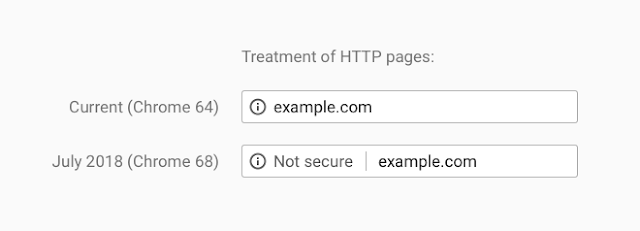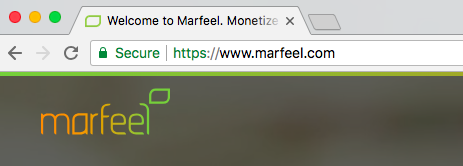The Reasons Publishers Need to Switch to HTTPS
The online ecosystem has aggressively been moving towards a more secure web with HTTPS encryption.
Starting in 2017, HTTPS (Hyper Text Transfer Protocol Secure) became the standard and necessary security protocol. Publishers fiercely started the mass migration to HTTPS with many more scrambling to catch up. There were several reasons for this shift.
Basic security precautions such as preventing external parties from accessing and tampering with a publisher's website and keeping the neutrality of Internet safe, were significant triggers. Others saw the push for HTTPS as another move in the chess match between network carriers and tech giants to dominate the growing online market, meaning that publishers needed to start serving content under HTTPS in order to remain competitive.
Even with the undeniable security benefits, the biggest triggers that made adopting HTTPS impossible to ignore came from major changes taken by browser vendors, operating systems, and Google itself. In advocating for HTTPS encryption, the following is what has made the digital publishing industry have to stop, look, and now act:
- Starting in July 2018, Chrome will label sites using HTTP as non-secure
- HTTPS is a must if publishers want to adopt key new mobile technologies like the underlying tech that power PWAs
- Sites using HTTPS receive better SEO ranking
- All ads will soon need to be served under HTTPS
- Accurate referrer metrics
Google Chrome non-secure label
Google Chrome recently announced that all HTTP connections will be identified with a non-secure label in Chrome's address bar when Chrome 68 is released in July 2018.

The non-secure label will not be limited to just sites that contain payment or login forms; any site with input fields including newsletter sign-ups and search fields will receive this treatment.
This automatic behavior and detrimental label doesn't only have the potential to damage the brand power that publishers work so hard to build and reinforce, it could also deter new visitors and naturally, the publication's revenue potential. For example, GlobalSign found that 84% of users would abandon a purchase if data was sent over an insecure connection.
In Chrome's current version, all HTTPS sites are already marked with a green address bar including a padlock and "Secure" label. This visual cue goes a long way to promote user fidelity and protect the life force of their business – their audience.

Adopting new technologies
The digital landscape has already moved towards providing a native app experience across the web. PWAs (Progressive Web Apps) are the next step in the UX evolution because they come with the invaluable features of native apps on the web that increase engagement and boost ad revenue.
Marfeel started delivering PWAs in 2017 because we identified the natural progression in the mobile market where PWAs wouldn't be a luxury, they would be a necessity to maximize traffic acquisition, engagement, and ad revenue.
To get a PWA, HTTPS is a hard requisite. This is because the APIs like service workers that power the features and frictionless experience of PWAs require HTTPS. Publishers that fail to adapt the new functionalities and technology that will define the mobile experience will see their market share and readership decrease.
To learn more about PWAs, see the Marfeel Progressive WebApps (PWAs) article.
SEO Boost
Organic traffic can sometimes be a major channel for publishers, driving new traffic to their content. For several years, Google has maintained that their crawlers favor the HTTPS version by default, giving sites with HTTPS encryption a slight ranking boost.
A report by Backlinko confirmed this, showing that sites with HTTPS encryption are linked with higher rankings on Google's first page. Considering that 75% of users never scroll past the first page of search results, any advantage publishers can get in SEO ranking is significant.
Ad revenue
One of the crucial benefits of migrating to HTTPS is that it boosts the security of a publisher's ad inventory, preventing external parties from inserting ads or manipulating a web page without compensation.
While at the moment, ad networks are not under direct imperatives to be under HTTPS, they will soon have to become compliant in order to maintain their market share and serve ads from their inventory of advertisers.
DFP is ahead of the curve in this regard and has already made HTTPS the default when serving ads in apps and is making a concentrated and aggressive effort to have all ads served with the improved security measure.
As in the case of Marfeel-produced Google AMP pages, some publishers have asked if adopting HTTPS might limit their ad revenue potential by invalidating specific ad servers and networks still operating with HTTP, however, the demand for impressions over HTTPS is clearly evident and does not have the detrimental effect on ad revenue that some publishers fear.
Marfeel makes billions of impressions over HTTPS and can attest to a very healthy and persistent inventory of purchasing advertisers.
Accurate referrer metrics
Google has also encouraged the HTTPS switch by modifying the Google Analytics Referrals tool.
HTTPS compliant websites do not send referral data to non-secure websites. The traffic instead is displayed as Direct in the Referrals tool. This means that insecure sites lose an important resource: Whenever a user clicks through to their HTTP site from and HTTPS domain, they lose the data to accurately track referrals.
Considering that 68% of Chrome traffic on Android and Windows, 78% of Chrome traffic on Chrome OS and Mac, and 81 of the top 100 sites are serving content under HTTPS, insecure sites will have noticed that tracking their referrers has become much more challenging as they see a rise in "direct" traffic instead.
Marfeel and HTTPS compliance
Marfeel has been HTTPS compliant for the last four years and anticipated this change in the mobile landscape - meaning that if a publisher's website is delivered through HTTPS, their Marfeel PWA is as well.
Marfeel also uses the HTTP/2 protocol through their CDN (content deliver network) - Fastly - to empower themselves and all their partners with enhanced reliability, performance, and the acute ability to deliver publishers' content globally with the instantaneous speed and optimal UX they're known for.
Keeping publishers and their valuable readers as a priority, Marfeel is working on the edge of innovation. Not only is Marfeel developing and rolling out new technologies at a high velocity, but we're also collaborators and early adopters of the latest APIs to bring partners and their readers the best mobile experience possible.
For more information on HTTPS and the reasons to make the switch, download our eBook.
Benefits of Switching to HTTPS - V3.pdf
For information on how to migrate to HTTPS, see the Switching to HTTPS article.